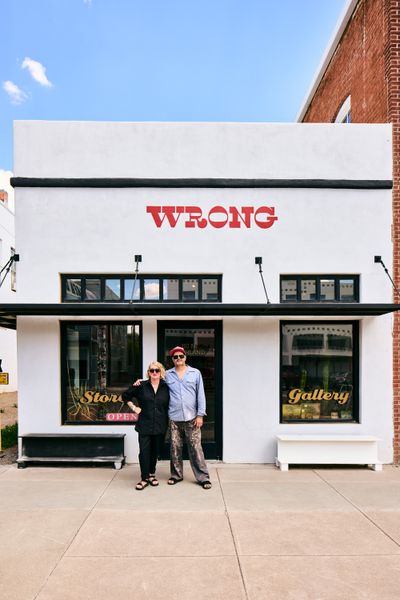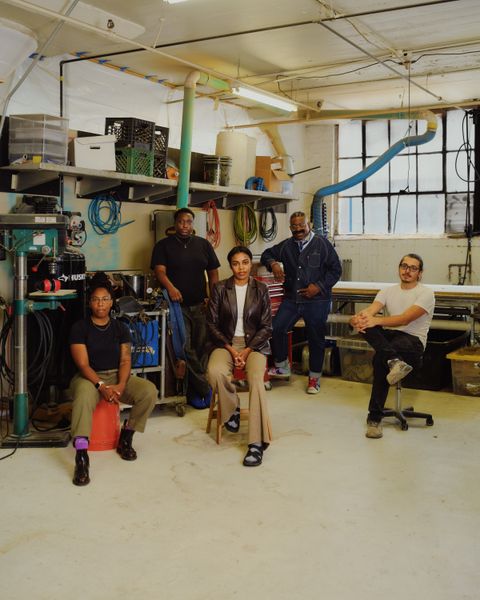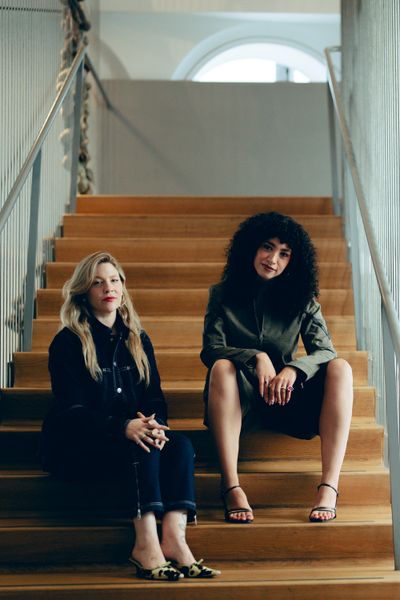From an eccentric gallery in Marfa to a co-op for Black and brown creatives in Chicago, these tastemakers are in the business of finding the brightest new talent out there.
Wrong
Artist couple Buck Johnston and Camp Bosworth adopt an approachable perspective to art and design with their wild and wonderful gallery, Wrong.

Before inhabiting a 2,000-square-foot space on N. Highland Avenue in Marfa, Wrong—the brainchild of Camp Bosworth (right) and Buck Johnston—thrived for years in an 1880s adobe church and parsonage.
Photo: Alex Marks
Celebrating its 15th anniversary this year, Wrong—the multihyphenate storefront, gallery, and bar known for its special curation of approachable art—is a feast for any design lover who finds themself in Marfa. With a population of 1,641, the town has long drawn fans of Donald Judd to the West Texas desert, but now also has its own eclectic creative scene.
Enter Wrong: When Buck Johnston and Camp Bosworth first stepped into the 2,000-square-foot space on N. Highland Avenue, which formerly housed the town’s barber shop, car dealership, and, most recently, the local newspaper’s headquarters, they had a vision. Today, the structure’s original windows light up with the bright desert sun, bouncing off lacquered hot pink floors—Johnston’s signature touch. "All artwork looks good with a pink floor," the former graphic designer says. A 1930s chandelier from the Hotel Paso del Norte in El Paso hangs above a custom asterisk-shaped table, giving patrons ample room to admire curated wares on each of the table’s wings.
Back in 2001, the couple, then living in Dallas, decided to test their burgeoning three-month-old relationship with a road trip out west. What started as a pit stop in Marfa ended up being a more permanent stay when they fell head over heels for the tiny town. At the time, the combination of gallery and storefront was a concept new to Marfa and came out of a desire to showcase Bosworth’s wooden artwork in a meaningful way. The idiosyncratic, off-kilter approach Bosworth brings to his personal artistic practice has always been a north star for Wrong. His work imagines everyday objects in wood—think ketchup packets, ice cream cones, and pork chops—as well as more illicit pleasures, like joints, tequila bottles, and $10,000 stacks of cash (or "drug money," as the sculptures are lovingly called, which go for $100 a pop).
"Generally, the things we curate are fun. There’s humor and levity to it," says Bosworth. But don’t mistake the pair’s laid-back attitude for indifference. "We’re easygoing but highly critical," says Johnston. A deep appreciation for craft, as in Boise, Idaho–based ceramist Lori Fish’s fantastically gestural, color-blocked vessels, and individuality, like local artist Cody Barber’s brightly hued, powder-coated horseshoes, are guiding principles. "It’s just work we love and people we love," says Johnston, who holds court behind the shop’s counter every day.
They’re aware that their cheeky style won’t suit everyone, but they’re more than content with the folks they do attract—and the platform they provide for up-and-coming artists in Marfa and beyond. With their Do Right Hall, they host up to 75 shows annually, offering artists free installation space and exposure to Wrong’s creative network. "My favorite thing to do is to write an artist a check," says Johnston.
Though the couple claim that Wrong’s evolution has unfolded off the cuff—"We just fell into it, and it worked," Johnston says—their keen curatorial eye and the community they’ve built solidifies Wrong as a Marfa mainstay. "If we get pushback, we know we’re doing something right," Bosworth confirms.
—Text by Trent Bullion
Cooperation Racine
In West Englewood, an artist buys an abandoned building to start a co-op for designers to share resources and profits.

Andrea Yarbrough, pictured at left with fellow Cooperation Racine founders Kayla Reefer (back left), Tavia David (center), Saleem Hue Penny (back right), and Andrés Lemus-Spont, emphasizes how the project creates new "cooperative creative economies" that serve existing tradespeople and trains members of often-excluded groups with a workforce development program.
Photo: Akilah Townsend
Artist and educator Andrea Yarbrough was woodworking and teaching the trade from her home on Chicago’s South Side. But the summertime wave of commissions, followed by winter lulls, was difficult, as was hustling to find fabrication services and studio space outside the small woodshop in her basement. In 2021, she saw a long-abandoned building in the West Englewood neighborhood listed for less than $5,000 and decided to buy it.
In 2023, Yarbrough convened a Zoom with 40 other artists. "I was like, Hey, y’all, I bought this building," she says. "Anybody want to start a co-op?"
Yarbrough and four other creative workers—photographer Kayla Reefer, poet Saleem Hue Penny, artist and fabricator Andrés Lemus-Spont, and sculptor Tavia David—have since founded Cooperation Racine, a worker cooperative association, to reimagine Chicago’s art and design ecosystem. Unlike conventional galleries, Cooperation Racine’s business shares both resources and profits, transforming the often-opaque "who you know" design scene into an expansive network of people who design, make, curate, and install art objects.
"We don’t see a lot of Black and brown people in the art-crating, art-shipping space. But there’s an opportunity there," explains Yarbrough, "not to be extractive, but to give people a space to build their skill set; have access to tools and resources, so they don’t have to buy their own; and then be able to leverage this space to do more."
The group is still in the building phase, giving themselves a long runway to amass a membership network while the to-be-rehabbed building awaits construction permits. But the team currently operates on something like a three-tiered membership system—"worker/owner," "worker/member," and "neighbor/member"—while providing fabrication, planning, and consulting services on architecture and design projects. The five worker/owners are stewarding a system that allows for worker/members to contribute to revenue-generating projects while also using the co-op’s resources and gallery spaces. Neighbor/members who aren’t artists or designers include those who want to financially support the co-op and forthcoming building itself.
Last year, the five worker/owners created handmade glazed tiles to support their capital campaign. Soon, they’ll also be releasing a line of member-made home goods, like ceramic salt-and-pepper shakers, jars, mugs, plates, and more cast from vintage 1970s and ’80s slip molds that the group unearthed during a recent residency with the Chicago Park District. All will be sold online, and profits will be shared.
The group’s model isn’t new; Hue Penny notes that members studied historic cooperatives like Cooperation Jackson, the Freedom Quilting Bee, and the Young Negroes’ Co-operative League "to make sure that we’re in conversation with the foremothers and the forebearers of the Black cooperative economic tradition." Still, theirs presents a dynamic, equitable model that ensures current and future art and design workers—especially those living and working in disinvested neighborhoods like Englewood—can thrive. Lemus-Spont says it’s about "finding a path, finding a community, and finding alternative models for success outside of capitalist structures."
—Text by Anjulie Rao
Kellie Riggs and Angelik Vizcarrondo-Laboy
For Objects: USA 2024, two curators brought their contrasting approaches to a comprehensive, diverse show highlighting American craft.

For Kellie Riggs (left) and Angelik Vizcarrondo-Laboy, cocurating Objects: USA at R & Company gallery in 2024 came as a coincidence. "We were contacted separately," recalls Vizcarrondo-Laboy; The gallery "didn’t know we knew each other or were friends." They are pictured here at the Museum of Arts and Design in Manhattan.
Photo by Amir Hamja
See the full story on Dwell.com: The Curators and Dealers Making the Next Generation of Design Stars in America
Related stories:
- Meet the Recipient of the First Frank Lloyd Wright Endowed Professorship
- The Vintage Furniture Seller Whose Brooklyn Store Cycles Through Aesthetics Every Six Weeks
- Here’s How Those Instagram Vintage Sellers Find Their Best Stuff
Read More
By: Dwell Staff
Title: The Curators and Dealers Making the Next Generation of Design Stars in America
Sourced From: www.dwell.com/article/best-design-curators-in-america-61a7b568
Published Date: Wed, 12 Nov 2025 13:02:19 GMT
.png)





